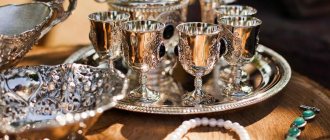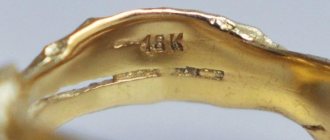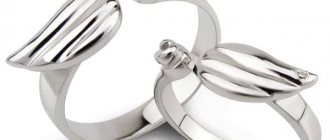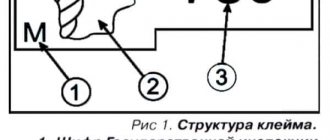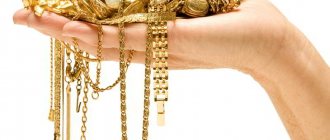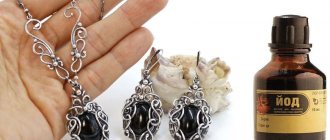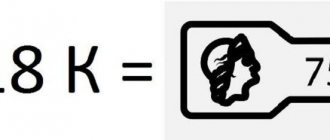The hallmark of gold and silver is a special mark that helps determine the amount of precious metal in the alloy. It is noteworthy that initially in Rus' only silver was hallmarked, but at the beginning of the 18th century gold was also hallmarked. There are several hallmark systems; previously, a special mark was placed on silver or gold. It contained information not only about the amount of precious metal in the ligature, but also about the craftsman who made the jewelry.
Ring test
Carat system
In Europe and the USA, a different system for indicating gold content is used - carat. Carats indicate the number of parts of pure gold from 24 parts of the alloy.
- 9 carat hallmark is 9 parts of gold out of 24 (375 hallmark)
- 10 carat hallmark is 10 parts of gold out of 24 (500 hallmark)
- 14 carat hallmark is 14 parts of gold out of 24 (585 hallmark)
- 18 carat hallmark is 18 parts of gold out of 24 (750 hallmark)
- 24 carat hallmark is 24 parts of gold out of 24 (pure gold).
The karat system is used today throughout the world. If you buy jewelry outside the CIS, the standard will almost always be indicated in the karat system.
Before the carat system in Western Europe, there was a lot standard (12 lots = 750 standard).
Where is the sample placed?
For each product, the location of the sample is different. On rings it can be placed both outside and inside the rim. On earrings, the hallmark is placed on the pin and earring. Pendant jewelry is branded on the hanging ring, and bracelets are branded on the last link at the lock. Wherever the sample is placed, every master strives to make it small and invisible, so it is better to use a magnifying glass to study the inscription.
In our jewelry workshop you can order jewelry of 585 and 750 gold in red, yellow and white. To do this, fill out an application on our website or call the number provided.
From the history of testing in Russia
The first Moscow hallmark on precious metal discovered in Russia dates back to 1651. The mark was an image of a double-headed eagle and a date indicated in Slavic letters. These were not yet complete samples in the modern sense, since they did not reflect the content of precious metal in the alloy. But such a mark was evidence that the metal corresponded to a model recognized by law.
In those days, the “Lyubsk thalers” or “efimkas” were considered the standard - these were imported European coins that were melted down into jewelry. At the end of the 17th century, “levok” appeared in Russia - a mark that indicated a low-grade gold sample.
State hallmarking in Russia was officially legalized in 1613 for silver, and in 1700 for gold. No mark was placed on other metals.
In all cities of Russia in the 18th-19th centuries they put a stamp with the image:
- coat of arms of the city, the year in a shield of various shapes;
- the initial letters of the jeweler's first and last name (the assayer's name);
- marks of the craftsman who made the product;
- two numbers indicating the sample (the number of spools in a ligature pound).
All craftsmen and jewelers in factories were required to put their name stamps and present the products to the state assayer.
Nowadays, the “manufacturer’s name” is the second mark that is required on a piece of jewelry. It is a kind of analogue of a label on clothing and contains information about the manufacturer. By deciphering the print, you can get the most complete information about the purchased jewelry. The “name” stamp is a four-digit alphabetic code enclosed in a single outline. It is rectangular in shape and, as a rule, is applied next to the “test”. The print contains four letters:
- The first will indicate the year when the product was produced (for example, “N” - 2012, “O” - 2013, “P” - 2014).
- The second will indicate the code of the Russian state assay inspection body where the product was tested (for example, “B” - Verkhne-Volzhskaya).
- The last two letters are the manufacturer’s individual code, which cannot be repeated within the same inspection.
Using the manufacturer's stamp, in case of doubt about the jewelry, you can find out when, where and by whom the jewelry you purchased was produced.
On January 1, 1899, a uniform stamp was introduced in Russia. The image represented a woman's head in a kokoshnik, with the initials of the manager of the assay district. Sometimes numbers were set - spool test (72 spools = 750 test). This type of marking, in different versions, existed until 1927, after which the system of testing and marking was changed. Instead of a woman’s head, the head of a worker with a hammer appeared in the kokoshnik, and the sample itself began to be designated by the number of thousandths of gold in the alloy, as is currently done. Platinum and palladium samples were added to the system. The hallmark contains the code of the assay office (a letter of the Greek alphabet).
Since 1958, Soviet hallmarks began to depict a hammer and sickle against the background of a five-pointed star. And the hallmark inspection code began to be denoted in Russian letters.
Since 1994, hallmarks have been introduced in Russia, which are currently in effect. Stamps with a hammer and sickle were in use until 2000.
Today, the stamp depicts a woman’s head in a kokoshnik in profile, directed to the right. Also depicted is a Russian letter - the code of the assay office. Each of the 18 assay inspections has its own letter.
Rules for hallmarking jewelry
State control has been established over samples of gold and silver. All products must undergo trial control and branding. Orders, medals and coins are not subject to stamping. However, their samples are regulated and controlled. Products made of precious metals without a hallmark cannot be bought or sold. counterfeiting of hallmarks is prohibited by law.
Test marks on products can have different shapes and designs. The drawing can be combined with the image of numbers corresponding to samples or with conventional numbers, each of which corresponds to a specific sample.
Which sample should I choose?
Looking at the treasures in the windows of jewelry stores, millions of buyers ask themselves the question - which sample to choose? Which is better?
If you do not have color preferences, then you need to choose a product according to three main criteria:
- practicality
- aesthetic appeal
- price
The most common gold standard is 583rd . The color of such a metal can vary - this directly depends on the percentage of various metals in the alloy. For example, if an alloy of 583-carat gold consists of 58.3% gold, 36% silver, 5.7% copper, then in this case the metal has a greenish tint. The same 583rd sample with a content of 18.3% silver, 23.4% copper, already has a pink tint. If this alloy contains 8.3% silver and 33.4% copper, then the gold will have distinct shades of red.
In general, 583- carat gold is considered the most practical, and therefore enjoys increased popularity. The 50% percentage of gold in the alloy makes the products durable - such jewelry is less scratched and does not deform.
The same cannot be said about 958-carat . This alloy is not durable, so it is not in high demand among jewelry buyers. This alloy also contains small amounts of silver and copper. The metal turns out to be bright yellow – almost pure gold. Often used in making wedding rings. But due to the increased softness, the surface of such jewelry requires regular polishing.
The alloy of 750 standard consists of 3 components - gold, copper, silver. Sometimes some rhodium, palladium, nickel and zinc are included as alloys. The color of the metal can be very diverse - from yellow-green to reddish and white. The alloy is very technical and ideal as a base for jewelry enamel. Almost always, jewelry made of 750-carat gold is distinguished by its noble shades and original, sophisticated design, since it is not produced in very large quantities.
The 375-carat gold alloy consists of the following components: 37.5% gold, 10.0% silver, 48.7% copper, 3.8% palladium. Widely used in the production of wedding rings.
How is the authenticity of precious metals determined?
When accepting a pledge and buying it at a pawnshop, a specialist checks the authenticity of precious metals using chemical reagents. They help to identify the content of precious metals in the alloy. The standard can be any: carat, spool, metric.
Methods for verifying the authenticity of precious materials
Products are tested at enterprises that monitor whether their quality meets established standards. Only after such verification is the mark of the corresponding sample applied. The testing methods there do not affect the appearance of the product and its composition.
Let's consider what verification methods can be used at jewelry factories, workshops, retail enterprises and institutions that issue loans secured by jewelry, pawnshops.
Touchstone
Touchstone - siliceous shale (contains 8% carbon, therefore black) for quick analysis of the authenticity of precious metals. The stone must have a smooth, fine-grained surface and chemical resistance to acids. There are no cracks, scratches, or heterogeneity. The stone can be of natural or artificial origin.
This method does not damage the integrity of the product, is easy to use and is suitable for determining any type of alloy.
Prepare the stone for testing by rubbing it with castor oil. Then “rubs” are made on it with the product - strips 15-20 mm long and 2-3 mm wide. Stripes are applied nearby with standard needles and then the whole thing is moistened with the required reagent. After the required exposure time, the reagent is removed with a blotter/filter paper and the precipitation is compared.
Assay needles
These are strips of alloys that correspond to a certain composition of the material and the presence of alloy components. The more materials included in the sample standard, the more complete the set of needles.
Image source https://stalstroyservis.ru/
Using a determinant
The 585 sample can be confirmed using a digital portable detector: in a few seconds the device will establish the content of the composition from 6 to 18 carats.
Image source https://jewelermarket.ru/
Reagents for sample verification
Preparation
The product is cleaned because it may be coated with a higher grade precious metal or a layer of dirt, grease, oxide film or colorless varnish. Clean the product using a special tool: a finely notched needle file or scraper.
Pawn scraper - a tool for cleaning products Image source https://jewelermarket.ru/
The appraiser should remember that items of historical and artistic value can be brought to a pawnshop. In such cases, the check must be carried out carefully with a scraper, not from the front side.
Reagent testing
Drip method
determining the amount of precious metal in the alloy: the surface of the product is cleaned, a reagent is dripped onto it. Assay reagents are produced by Assay Supervision Inspectors.
When using reagents, avoid contact with skin and mucous membranes. Use reagents at room temperature. You need to store them:
- with a sticker indicating the purpose of the reagent,
- in pencil cases with recesses for bottles,
- in a cool and dark place without moisture,
- away from household appliances and other metal surfaces.
A precipitate should not form; reagents must be changed if it appears (after 2-3 months for high-grade gold, after 6 months for other reagents).
Image source 1nerudnyi.ru
What reagents are used:
- Gold chloride solution
– for gold up to 600 samples.
The use of gold chloride makes it possible to identify a wide range of alloys, establishing the presence of a fraction of gold in the composition of the material according to the degree of oxidation and color saturation. An experienced specialist can use gold chloride to identify silver among other white metals. The lower the gold grade, the richer the color of the stain. The product of sample 999-585 does not interact with the reagent; on sample 583 it will leave a weak, barely noticeable trace.
- Acid reagents for gold
750, 900 and 958 samples.
Pure nitric acid is the most common way to determine a sample below 583. In this case, a reaction occurs with the release of gas: the lower the gold content, the more intense bubbles are released under a drop of acid.
The action of acid reagents determines gold samples from 333 to 900.
The sequence of testing gold with an acid reagent:
– rub a small sample of the product on a special stone mechanically,
– apply the reagent to the material with a glass rod,
– compare the result of a chemical reaction and established standards.
- Potassium dichromate solution (chrompic)
for silver not lower than 600 standard.
Under its influence, a dark brown-red sediment will remain on 600 silver. As the sample increases, the brightness of the spot increases:
- 780-820 sample – orange color,
- 875 standard – red color,
- above 900 standard – bright red, bloody.
- Silver nitrate solutions
for silver 500, 750, 800, 875, 916, 925, 960 samples.
In this case, a weak gray-white coating is formed, the saturation of which, as the sample decreases, intensifies to an ash-gray hue.
- Potassium iodide solution
for platinum and alloys with high precious metal content.
Using this solution, counterfeit metals that are resistant to other reagents are identified. It does not work on alloys that start at 900 fineness. 800 fineness items and highly chemical resistant jewelry will show a green/black stain with possible bubbling.
- Acid reagent for the 958th sample
for gold alloys.
The quantitative composition of gold in the alloy is determined by the color of the reaction. If the gold darkens during the reaction, it means it has a lower purity than 958.
Checking gold items
After cleaning, a drop of gold chloride
, the sample and metal of the product are determined:
- for rose gold:
- 585 sample after 10-15 seconds there will be a faint light spot or there will be none,
- 500 sample after 5-7 seconds - chestnut spot;
- 583 or 585 samples with nickel in the composition - an orange-golden spot,
- 583 or 585 samples with palladium in the composition - a pale brown spot;
- 375 sample - after 1-2 seconds a brown spot will appear, and then a dark green one,
- 333 samples, a brown-green spot will appear instantly.
Checking silver items
A solution of potassium dichromate (chrompic) is used on the cleaned product, which acquires different shades of red:
- 600 silver is brown/dark brown;
- 780-820 samples - brown shades turn into red-orange;
- 875 samples – red;
- above 900 standard – dark red;
- below 600 sample the reaction stops.
Silver alloys of 500, 750, 800, 875, 916, 925, 960 samples are tested using silver nitrate solutions. In this case, a gray-white coating is formed; as the sample decreases, the color will intensify to an ash-gray hue.
Inspection of platinum products
A solution of potassium iodide and an acid reagent for 958 gold are taken. Platinum 950 and iron alloys rich in Ni and Cr will not react to them; dark brown spots will remain on white gold.
Inspection of palladium products
The effect is a solution of potassium iodide: 850 sample - an orange spot, 500 sample - light orange.
Remedium
– permissible deviation of the sample from the one declared:
- gold ±5 shares,
- silver ±15 shares,
- platinum ±10 shares,
- palladium ±15 parts.
White gold
White gold, in fact, does not exist. This is ordinary gold with different metal contents in the alloy.
- 585-carat white gold: 23.7-28.7% - silver, 13.0-18% - palladium, 17% - nickel, 8.7% - zinc, 16% - copper.
- 18k white gold: 7.0-15.0% silver, 14% palladium, 4% nickel, 2.4% zinc, 7.5-16.5% nickel, 15% copper .
White gold is in high demand among jewelry lovers and is an excellent companion for diamonds.
Silver
In Russia, the following silver standards are legally permitted for use: 800, 830, 875, 925, 960, 999.
875 standard silver is the most practical and widespread. It is from this alloy that most silver jewelry is made. The alloy contains 81.5% pure silver. The rest is made up of copper, which effectively prevents the oxidation of the metal. 875 sterling silver is less susceptible to tarnishing than 830 and 720 sterling silver.
Tableware items are made from 916 sterling silver. The 960-grade alloy is used in the manufacture of particularly filigree products.
To protect silver and brass items from oxidation, their surface is often coated with a thin layer of .999 gold (gilding) or .999 silver (silver plating).
Platinum and palladium
In jewelry, platinum and palladium alloys are used in very small quantities.
Platinum alloy is being successfully replaced today by white gold. Some jewelry is made from a two-component 950-carat alloy, which contains copper and iridium along with platinum.
Palladium has not yet been recognized as an independent metal for the production of jewelry. However, palladium has a very good future because it is cheaper than platinum, has a rich white color, excellent machinability and a long-lasting luster.

